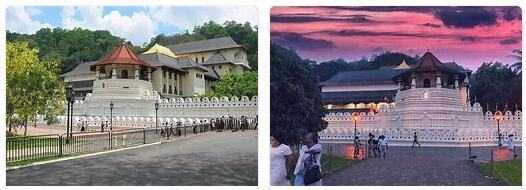Kandy, called Senkadagalapura in the 14th century, was the last capital of the independent Sinhalese kingdom from the 16th to the 19th centuries. Thanks to a tooth relic of the Buddha, it is still one of the most important religious centers in the country. The relic is kept in the Dalada Maligava Temple (Temple of the Tooth). Once a year the eleven-day Perahera procession takes place in honor of the Buddha tooth and the gods.
Holy City of Kandy: Facts
| Official title: | Holy City of Kandy |
| Cultural monument: | in the residence of Sinhalese kings the “Temple of the Tooth” Dalada Maligawa with the relic of a tooth of Buddha; famous Buddhist monasteries such as Malwatte Maha Viharaya as well as Asgiriya Maha Viharaya and the Hindu temple Natha Dewale |
| Continent: | Asia |
| Country: | Sri Lanka |
| Location: | Kandy, northeast of Colombo |
| Appointment: | 1988 |
| Meaning: | from 16.-19. Center of a Sinhalese kingdom that was independent of the colonial powers and, thanks to the »Temple of the Tooth«, a famous and important Buddhist pilgrimage site |
Holy City of Kandy: History
| 14th century | Natha Dewale, one of four important Hindu temples in the city |
| 1707-39 | Construction of today’s temple of the tooth under King Narendrasingha and expansion under his successors |
| 1784 | Construction of the audience hall |
| 1798-1815 | Reign of the last Kandy king Sri Vikrama Rajasingha |
| 1801 | Plant of the Kandy lake |
| 1815 | Captured by British colonial troops and the Kandy Convention signed |
| 1913 | Hermann Hesse publishes travel notes, essays and the “diary sheet from Kandy” in his notes “From India” |
| 1972 | Proclamation of the Republic of Sri Lanka |
Lotus flowers for the Buddha’s tooth
The morning mist slowly creeps up the palm stems on the banks of the Mahaweli River, which loops around Sri Lanka’s holy city of Kandy. Locals take advantage of the morning freshness and scrub their laundry in the gray-brown river water. Early in the morning the nearby jungle vibrates with joie de vivre: birds chirping in various tones, plus the buzzing of insects, high-pitched screeches of individual monkeys. In the distance an elephant trumpets in between. The sun slowly wins over the haze – overture for a new morning: daybreak in the holy city of Kandy in the highlands of Sri Lanka and everyday life on the edge of a city that stands for awe, devotion and power.
Nevertheless: despite all its religiosity, Kandy is not a quiet city. Traffic chaos and a horn concert are simply part of it. You have to wring contemplation from everyday life. According to thereligionfaqs, the most important Buddhist shrine is located in this second largest metropolis in Sri Lanka: Dalada Maligawa – the “Temple of the Sacred Tooth”, in which a Buddha’s canine tooth is kept as a relic. There are also two important Buddhist monasteries – Asgiriya and Malwatte Maha, which is particularly beautiful on Lake Kandy.
From the 14th century to the year of the Congress of Vienna, Kandy was the capital of the Ceylonese island kingdom. With the capture of the last Sinhalese king Sri Vikrama Rajasingha by the English in 1815, the city lost this status. Today the city mainly attracts Buddhist pilgrims and, in their wake, tourists interested in culture. Your destination: Dalada Maligawa.
Three times a day the orange-clad monks allow the endless lines of believers to see the outermost shrine with the Buddha’s tooth. The actual relic is only located in the innermost part of seven nested boxes. The monks receive either lotus blossoms or rupee notes as offerings from the visitors. You can’t help but get the impression that they are rather bored when they accept the beautiful flowers and prefer to put on their smile for cash offerings first.
The few normal mortals who have ever seen the relic without the shrine being blinded, however, rumor that it is much too big for a human tooth. Nevertheless, the veneration on the island is unbroken, and the legends that surround it are diverse. According to this, it should have been a princess who brought it – hidden in her hair – from India to the island, where it had to change its place of storage many times over the centuries in the wake of warlike threats. The tooth was always seen as a symbol of power for the rule of the island.
Hollywood has also already expressed its interest in Kandy and the surrounding palm forests and has given the area a monument on celluloid. Steven Spielberg, say the locals, shot scenes here for the world hit movie “Indiana Jones and the Temple of Doom” with Harrison Ford in the lead role for weeks.
Kandy is famous for its temple dances – meanwhile a predominantly tourist and at the same time impressive spectacle, which culminates in the “fire run” over glowing coals. Originally these dances were only performed at sacrificial ceremonies. Today they are brought to the stage every evening in sold out houses in front of hundreds of spectators. The performances during the annual Perahera of Kandy, celebrations that – depending on the full moon – fall in the period July / August and last for eleven days, are unsurpassed. In honor of the Hindu deities Vishnu, Natha and Skanda, as well as to worship the Buddha tooth, there are nightly processions in which hundreds of dancers from all corners of the island march through the streets together with decorated elephants.
